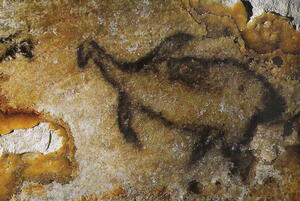Underwater sanctuary, 27,000 years old
These are masterpieces that we will never see with our own eyes—paintings, engravings, and hand stencils dating from 27,000 years ago when a sparse population occupied the cold and barren Mediterranean seaside. These works of art are so fragile and precious that the underwater passage leading to them has been sealed off by the authorities.
Only a few people have actually seen the marvels of the Cosquer Cave: the professional diver from Cassis who discovered it in 1985 and gave it his name, and a handful of divers-archaeologists who were commissioned to perform a thorough survey once the discovery was officially declared to the authorities in 1991.
Some 27,000 years ago, when the Cosquer artists were at work on the walls of the cave, sea level was about a hundred meters lower than it is today. The coastline was located 10 kilometres further to the south and the landscape was reminiscent of present-day Norway. Men were few; but antelopes, giant stags, horses, small penguins called auks, bison and aurochs abounded.
Today, the entrance to the Grotte Cosquer is 37 metres below sea level in one of the Calanques, the small Mediterranean fjords that dent the coastline between Marseille and Cassis.
Like Lascaux in southwestern France, or Altamira in nearby Spain, the cave was a place of magic and worship. Rock, or "parietal," art is the prehistoric equivalent to statues, paintings and stained glass windows in present-day cathedrals. "The Cosquer Cave," say archaeologists Jean Courtin and Jean Clottes, "was probably one of the most important sanctuaries of the Upper Palaeolithic." Some 27,000 years ago in what is now Provence, men gathered there, in the entrails of the Earth, to communicate with the spirits and forces of Nature.
Over the past millennia, nearly four-fifths of the sanctuary were submerged, and the artwork erased through corrosion or algae growth. What remains, though, is enough to make us marvel at the talent of these Palaeolithic artists.
Close to 180 animals, belonging to 11 different species, are represented on the cave walls—considerably more than in Lascaux or Altamira. The Cosquer engravings that depict marine animals like the little "auk" penguin have no known equivalent in the world of parietal art.




